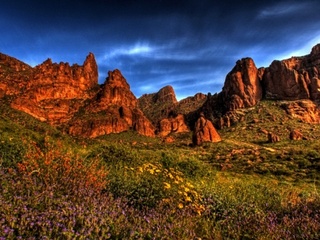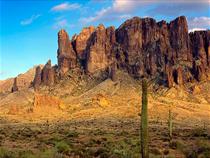Superstitions Take Three
Posted by: Loren Coleman on January 18th, 2011

The Superstition Mountains in Arizona are known for two major legends, the Lost Dutchman Mine’s gold and Bigfoot.
Over the weekend, news of three more people who died in pursuit of the Superstitions’ mysteries was noted by the media.
Authorities said the skeletal remains of a third missing Utah man may have been found in the Superstition Mountains on Saturday, January 15, 2010. Officials noted on Monday, January 17th, that they found the wallet of Curtis Merworth along side those human remains.

Officials believe they’ve found the remains of Curtis Merworth in Arizona.
Maricopa County Sheriff’s Office spokesman Jeff Sprong said the office was contacted around 12:45 p.m. Saturday by a subject who reported finding possible human skeletal remains.
Sprong said the person told them it is one person and possibly the third hiker from the group that went missing last July 2010.

Curtis Merworth, Ardean Charles and Malcolm Meeks were all from Salt Lake City, Utah.
Sixty-six-year-old Ardean Charles, 51-year-old Malcom Meeks and 49-year-old Kurtis Merworth told family and friends they were traveling to Arizona to find the Lost Dutchman’s gold, believed to be hidden in the mountains. Two of the three men were said to have medical conditions.
The three men were lured like countless others to the rugged landscape by tales of gold treasures that date back to the gold-rush days of the 1800s. The men have been in the Superstition Mountains — where the temperatures were upwards of 115 degrees — possibly a week before they were reported as missing last summer.
Sprong said searchers were in the mountains with the person locating the remains. Pima County Sheriff Officials believe they found the remains of Ardean Charles and Malcom Meeks a week previously.
Arizona historian Marshall Trimble said the legendary Lost Dutchman’s Mine has claimed an estimated 100 lives, with many explorers perishing in the unforgiving terrain.
“It’s very unforgiving,” Trimble told ABC News last July. “The last thing anybody wants to do is go out there this time of year. It’s just too hot. The lure of it is that it’s a kind of mystical place said to have magnetic magical powers. There are people who claim they have seen aliens out there from outer space and legends of Apache who protect the treasure.”
The Dutchman himself was actually German, a man named Jacob Waltz, who lived in Phoenix and is said to have died with gold under his deathbed, Trimble said.
“People from all over the country have come out looking for the Dutchman’s gold,” he said. “It’s like the lottery or the Power Ball. People think, ‘I’ll be the one to find it.’ They’re dreamers.”
But Trimble explorers rarely make it out alive.
“It’s a pretty hostile place, full of cactus and rattlesnakes and twisting canyons,” he said. “There is water but it’s hard to find and it’s 115 degrees in the shade. It doesn’t take long, if you aren’t careful, to get your brain fried.”

In 2007, reports of a Bigfoot in the Superstition wilderness area circulated in the press. Earlier in 2002, it was reported that a large upright animal spooked a rider and pack horse near the head waters of Rough Canyon along the northern edge of White Mountain. Rough Canyon is almost impossible to hike through. The area is extremely remote and ignored by many. The rider who reported the large upright animal was trying to get to the head of Rough Canyon to set up a camp and explore the area for archaeological sites. He claimed he was studying the pattern of inhabited areas north of White Mountain and south of Reavis Mountain.
The forests of Ponderosa pines in the Superstitions were searched in the early 1980s for Bigfoot. Whether it is hidden treasure or unknown hairy beasts, the mountains have a strong attraction to searchers.
People who get lost in the Supersition Mountains and die due to their inability to find things to eat or water suffer from the same mentality that cause folks to say things like “there’s nothing there that Bigfoot could eat or drink.”
Of course, the place is teaming with life.
Vegetation is primarily that of the Sonoran Desert, with semidesert grassland and chaparral higher up. Dense brushland covers hundreds of acres. A few isolated pockets of ponderosa pine may be found at the highest elevations.
The Superstition Mountains support many species of animals, including a high number of mammals.
The records from nearby Tonto National Monument demonstrate the area’s great diversity of plant and animal life. There are at least 26 species of land mammals, as well as over a dozen species of bats. This diversity can be explained in part by the Monument’s location between the Superstition Mountains and the Salt River valley. Several species are found only in lower, drier elevations, while others favor the higher slopes.
During hot weather, desert mammals are typically most active at dawn and dusk. Some retreat to burrows to escape the heat, others find a shady spot somewhere. Many mammals shed their thick winter fur, or rely on large ears to get rid of excess body heat. Panting is an efficient way to cool the body; evaporative cooling in the nasal passages helps to cool the brain.
All animals have a need for water. Some rodents, such as pocket mice, get all their water from their food. Deer, coyotes, and bighorn sheep have home ranges that include water holes.
(Click here to read the list of animals that eat and survive, and are eaten in the area.)
People who explore the area for Bigfoot or gold are often not doing research on the conditions that might await them, before they go into this wilderness areas of Arizona.
For example, bears do not “hiberate” in the SW USA like they would in Alaska or even the Rockies, and they are a danger to treasure hunters, hikers, and Bigfoot hunters.
About Loren Coleman
Loren Coleman is one of the world’s leading cryptozoologists, some say “the” leading living cryptozoologist. Certainly, he is acknowledged as the current living American researcher and writer who has most popularized cryptozoology in the late 20th and early 21st centuries.
Starting his fieldwork and investigations in 1960, after traveling and trekking extensively in pursuit of cryptozoological mysteries, Coleman began writing to share his experiences in 1969. An honorary member of Ivan T. Sanderson’s Society for the Investigation of the Unexplained in the 1970s, Coleman has been bestowed with similar honorary memberships of the North Idaho College Cryptozoology Club in 1983, and in subsequent years, that of the British Columbia Scientific Cryptozoology Club, CryptoSafari International, and other international organizations. He was also a Life Member and Benefactor of the International Society of Cryptozoology (now-defunct).
Loren Coleman’s daily blog, as a member of the Cryptomundo Team, served as an ongoing avenue of communication for the ever-growing body of cryptozoo news from 2005 through 2013. He returned as an infrequent contributor beginning Halloween week of 2015.
Coleman is the founder in 2003, and current director of the International Cryptozoology Museum in Portland, Maine.










Why, the Superstition Mountains sound like the perfect habitat for an animal adapted to the Pacific Northwest!
Seriously, these may be the most well-named geographic feature in the United States.
Actually this is not a huge stretch for the presence of BF (at least occasionally). Especially if it is along some sort of migration route.
Arizona has the largest stand of ponderosa pines in the country, it’s just that most of them are concentrated in the northern half of the state. I have seen snow on the cactus in the Supers on rare occasions. It’s true the summer is a bitch and will kill you if you are not prepared, but at night and in the winter its a nice place to explore. The most dangerous thing up there are the Dutchman cultists convinced they have figured out the “secret” of the mine’s location. Some of these wackos will kill you.
There is also a river (the Salt) that flows near the base of the mountains and several man made lakes within the area. The gold from the Dutchman’s mine is believed to have been processed at the bottom of Canyon Lake (before it was a lake). So there are patches of riparian habitat throughout the region.
Fair enough, and of course there are plenty of other animals with ranges that extend from the desert Southwest up into Canada. Bears come to mind, as do bison; both are large animals I would probably expect to find mostly in cold climates, where their size would help retain heat. Lowland gorillas also live in hot environments, as do orangutans. In spite of those examples, I still have the feeling heat would be a serious problem for Sasquatch, assuming we’re talking about a bipedal ape and nothing paranormal.
As for the idea of a migration, are any primates known to migrate? Humans may follow migratory game or seasonal rains (mostly for agriculture), but that’s intentional, not instinctive, behavior, and I don’t see much potential for a parallel with Bigfoot.